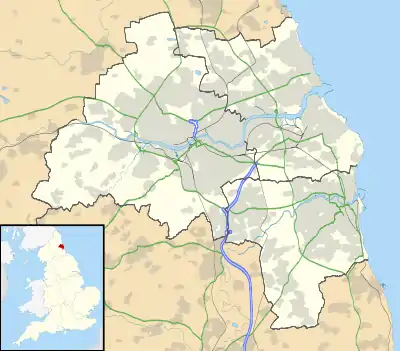Forest Hall
Forest Hall is an area east of Benton in North Tyneside in the north of England. Forest Hall, called after a long gone palatial residence, is a north eastern suburb of Newcastle, adjacent to but fiercely separate from Killingworth. Until the mid 1960s it was a sleepy village with a railway station on the main line to Edinburgh.
| Forest Hall | |
|---|---|
 Forest Hall Location within Tyne and Wear | |
| Population | Approx. 2,500-5,000 |
| OS grid reference | NZ269683 |
| Metropolitan borough | |
| Metropolitan county | |
| Region | |
| Country | England |
| Sovereign state | United Kingdom |
| Post town | NEWCASTLE UPON TYNE |
| Postcode district | NE12 |
| Dialling code | 0191 |
| Police | Northumbria |
| Fire | Tyne and Wear |
| Ambulance | North East |
| UK Parliament | |
Facilities
There are pubs, social clubs such as Forest Hall Ex-Servicemens institute. There's a shopping centre with a variety of shops, take away food outlets, restaurants, two supermarkets and a Health Centre. Forest Hall has frequent buses through the village centre; Newcastle upon Tyne City centre is approximately 15–20 minutes travel by bus. Benton Metro station is about a half mile from the centre of Forest Hall.
The East Coast Main Line runs through Forest Hall. The old Forest Hall station was closed down in 1958 and subsequently demolished in 1964.[1] A public house, "The Flying Scotsman," was opened on the site of the old railway station in May 1969, named after the Flying Scotsman rail service that uses the route.
At the heart of Forest Hall lies the well frequented Springfield Park which benefits from open spaces, a large play area as well as a Bowling Green and Forest Hall Community Tennis Club.
Schools
Primary schools in the area include Forest Hall Primary School, Ivy Road Primary School, and St Mary's RC Primary School.
For further education there is Longbenton Community College in Benton and George Stephenson High School to the North in Killingworth and St Marys Catholic School to the south west close to South Gosforth.
Churches
Forest Hall has several churches of different denominations: St Bartholomew's Church, Long Benton (C of E), St Andrews Methodist United Reformed Church, St Mary's Roman Catholic Church, and Bethesda Gospel Hall.
Places of interest
George Stephenson's Dial Cottage.
George Stephenson became an assistant to his father and later followed in his footsteps to become the engine man at Killingworth colliery. It was there that Stephenson developed one of the earliest locomotives, called the Blücher, which ran on the Killingworth colliery railway in 1814. It was capable of pulling 30 tons up a grade at 4 miles per hour. He also persuaded the mine manager to experiment with steam locomotion, and over the next several years Stephenson had built a further 16 engines at Killingworth.
While developing the Blücher, Stephenson lived in "Dial Cottage," which still stands on the Great Lime Road in Forest Hall, south of Killingworth. When George moved in the cottage consisted of one room and a garret reached by a ladder. By the time he left he had extended and converted the premises to become a comfortable four-roomed house.[1] The cottage has a sundial, made by Stephenson himself, and a plaque above the door which reads
“ George Stephenson engineer. Inventor of the Locomotive Engine lived in this cottage from (1805 to 1823), his first locomotive (Blücher) was built at the adjacent colliery wagon shops, and on July 25, 1814 was placed on the wagonway which crosses the road at the East end of this cottage.
External links
![]() Media related to Forest Hall at Wikimedia Commons
Media related to Forest Hall at Wikimedia Commons